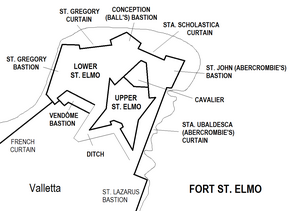Fort Saint Elmo
| Fort Saint Elmo | |
|---|---|
| Forti Sant'Iermu | |
| Part of the fortifications of Valletta | |
| Valletta, Malta | |

Fort Saint Elmo main entry after restoration
|
|

Map of Fort St. Elmo
|
|
| Coordinates | 35°54′7″N 14°31′7″E / 35.90194°N 14.51861°E |
| Type | Star fort integrated into a city wall |
| Area | 50,400 m2 (543,000 sq ft) |
| Site information | |
| Owner | Government of Malta |
| Controlled by |
Heritage Malta Police Academy |
| Open to the public |
Yes |
| Condition | Intact |
| Site history | |
| Built | 1552–1570s |
| Built by | Order of Saint John |
| In use | 1552–1972 |
| Materials | Limestone |
| Battles/wars |
Great Siege of Malta World War II |
| Events | Rising of the Priests |
Fort Saint Elmo (Maltese: Forti Sant'Iermu) is a star fort in Valletta, Malta. It stands on the seaward shore of the Sciberras Peninsula that divides Marsamxett Harbour from Grand Harbour, and commands the entrances to both harbours along with Fort Tigné and Fort Ricasoli. It is best known for its role in the Great Siege of Malta of 1565.
By 1417, the local militia had already established a permanent watch post on the tip of the Sciberras Peninsula. In 1488, the Aragonese built a watchtower on Saint Elmo Point, and it was dedicated to Erasmus of Formia, better known as Saint Elmo. In 1533, the Order of Saint John reinforced the tower due to its strategic location. In 1551, an Ottoman raid occurred in which the Turkish fleet sailed into Marsamxett Harbour unopposed. Due to this, it was decided that a major expansion was necessary, and in 1552 the tower was demolished and a new star fort began to be built. It was designed by four Italian architects and had a cavalier, a covertway and a tenaille. A ravelin was hastily constructed months before the 1565 siege.
In 1565, the Ottomans invaded Malta once again with much more force than in 1551, in the Great Siege of Malta. Fort Saint Elmo was the scene of some of the most intense fighting of this siege, and it withstood massive bombardment from Turkish cannon deployed on Mount Sciberras that overlooked the fort and from batteries on the north arm of Marsamextt Harbour, the present site of Fort Tigné. The initial garrison of the fort was around one hundred and fifty knights and six hundred soldiers, the majority of which were Spanish, and sixty armed galley slaves. The garrison could be reinforced by boat from the forts across the Grand Harbour at Birgu and Senglea.
...
Wikipedia
